 |
Hollywood reporters are calling it one of the biggest flops
in movie history. But is the movie really that bad?
Maybe It Should Have Been A Princess of Mars.
Who Is John Carter?
By Ron Fritze from Athens, Alabama
March 20, 2012
The headline asks, "Who Is John Carter?" That’s a silly question to ask of anyone who is a fan of Edgar Rice Burroughs. Most people know that Burroughs was the creator of Tarzan, one of the best known figures of popular culture. Burroughs wrote twenty-three Tarzan novels and the ape-man has been the subject of far more movies, so he’s gotten plenty of exposure. Fewer people know that Burroughs created several other series: one set on Venus, another on a prehistoric world at the earth’s core, and a third Mars. He also wrote other novels with locales on lost prehistoric islands and the moon. The most accomplished of these were Burroughs's Mars series about the adventures of John Carter, the eponymous protagonist of the new Disney film.
People generally assume that Tarzan of the Apes was the work that got Burroughs started as an author of popular fiction. That is because Tarzan of the Apes was the first of his works to appear in book form. A. C. McClurg & Company of Chicago brought it out in 1914 and followed the next year with The Return of Tarzan. But Tarzan of the Apes was not Burroughs's first venture as a writer of popular fiction. During July of 1911, Burroughs began to write a story set on Mars. Before mid-August he had submitted forty-three thousand words of his story to The All-Story, a monthly magazine edited by Thomas Newell Metcalf. The All-Story was one of the many magazines known as “pulps” that published serialized novels. These magazines were known as “pulps” because of the cheap, wood-pulp paper on which they were printed. Although his original title was “Under the Moons of Mars,” the story was eventually published as A Princess of Mars. It appeared in The All-Story issues for February through July 1912, although the editors didn't choose to feature the tale on any of the covers.
 By March 1912 Burroughs was already working on his Tarzan story. Thanks to the success of A Princess of Mars, Metcalf was anxious for more of Burroughs's work, so when Burroughs provided a synopsis of the Tarzan story, the editor responded enthusiastically. Burroughs submitted the completed typescript on 11 June and Metcalf scheduled Tarzan of the Apes to appear complete in the October 1912 issue of The All-Story. It proved even more popular than A Princess of Mars.
The Creator of John Carter
Was Also a Savvy Businessman.
Readers clamored for sequels to both novels. Burroughs and Metcalf readily obliged, setting in motion a publishing venture of epic proportions. Burroughs eventually became the most popular and widely read author of the first half of the twentieth century. He also became the first author to understand and exploit the multimedia potential of his stories. As his sales figures climbed, the possibilities for subsidiary rights grew accordingly. Newspapers were serializing novels as they'd done for decades, but the rising new mediums of film and radio also needed stories to wrap around the commercials they wanted to peddle to their viewers and listeners. Burroughs negotiated to keep these rights for himself, becoming the first author to incorporate himself.
Oddly enough, while Tarzan has appeared on the silver screen many times, John Carter was not so lucky. During the 1930s, a project to make Burroughs's Mars stories into an animated, feature-length film was started but never completed. If the project had reached fruition, it would have predated by a year Disney's ground-breaking animated feature, Snow White and the Seven Dwarfs. Other discussions about a John Carter film arose over the years but never materialized. So, at last, only a few months before the Mayan calendar brings us to the end of time, the 2012 Disney feature arrives on the silver screen.
Mind you, the Sy Fy Channel brought out a made-for-TV movie based on John Carter about a year ago. That dreary film’s dubious claim to fame was the appearance of reformed pornographic actress Traci Lords in the cast of a lackluster production. At that time I remember reading about plans for a theatrical John Carter movie. I was also apprehensive that Disney would blow it.
John Carter in 1940 ~ a Dell paperback
We Already Knew about Tarzan.
Knothe Showed Us the Path to Mars.
John Carter and I go way back — and by way back I mean 1963 when I was in sixth grade at Holy Cross Lutheran School in Fort Wayne, Indiana. My friends and I had already discovered science fiction as fourth graders. We were reading whatever we could get into our grubby hands. Then came Steve Knothe, a wise old seventh grader, who introduced us to the John Carter books. We all knew about Tarzan and Johnny Weissmuller but we didn’t know that the man who had created Tarzan had also written science fiction. By the way, none of us had read Tarzan of the Apes. We liked the movie and liked to emulate the Tarzan yell, but in terms of reading, we were devoted to science fiction.
In those days, access to a good selection of books was limited. Drugstores featured racks of paperbacks, but titles in the genre of science fiction were slim to erratic. Well-stocked bookstores were rare in Fort Wayne. The best selection could be found at Old Fort, although the up-scale department store Wolf and Dessaur offered a good selection, too. Ten Mars novels were on the market In the early 60s. An eleventh was published posthumously well after Burroughs death in 1950. Knothe owned three of them—the third in the series, The Warlord of Mars; the eighth, The Swords of Mars; and the tenth, Llana of Gathol, which was really a collection of novelettes. The common thread in each was the presence of John Carter.
Of course, you might say! But no! Every Tarzan novel featured Tarzan as its protagonist, but after the third Mars novel, Burroughs decided to base books four through seven on other characters. As young readers with Knothe's library of three titles, we faced a problem: The Warlord of Mars was the third of a trilogy which was preceded by A Princess of Mars and The Gods of Mars. We loved the non-stop action of The Warlord of Mars and longed to get a hold of the first and second books. As it was, I ended up reading the trilogy in reverse order because I found The Gods of Mars first.
Carter's Escape Route
From Apache Warriors
Leads All the Way to Mars.
The film John Carter is based on A Princess of Mars. How did Disney do with the adaptation? Actually, pretty good. In A Princess of Mars, John Carter is prospecting for gold in Arizona but runs into big trouble from a massive band of ruthless and cruel Apache warriors. Taking refuge in a cave, he succumbs to fumes, becomes paralyzed, and then enters into an out-of-body experience that transports him to Mars. The plot line fits nicely into the popular culture of the era. In 1912 spiritualism and séances were a craze of late Victorian and Edwardian popular culture.
Waking up on Mars, Carter, already a prime physical specimen, finds he possesses super-human abilities. The gravity of Mars
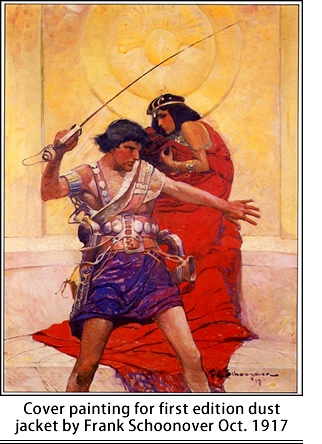 is one third of earth’s, so whatever Carter could do on earth, he could do at least three times better, higher, and farther on Mars. Carter finds Mars to be a desert world that is slowly dying due to loss of water and atmosphere. Former seas are now waterless basins covered in a yellow moss. Living on this harsh land are several races, including the race of Carter's first contact, green men who stand 12-to-15 feet tall with two pairs of arms. They are ugly creatures, very, very warlike and devoid of tender emotion. For them, intense cruelty passes for humor, which means that the culture of green Martians is stuck at the level of many American high schools.
is one third of earth’s, so whatever Carter could do on earth, he could do at least three times better, higher, and farther on Mars. Carter finds Mars to be a desert world that is slowly dying due to loss of water and atmosphere. Former seas are now waterless basins covered in a yellow moss. Living on this harsh land are several races, including the race of Carter's first contact, green men who stand 12-to-15 feet tall with two pairs of arms. They are ugly creatures, very, very warlike and devoid of tender emotion. For them, intense cruelty passes for humor, which means that the culture of green Martians is stuck at the level of many American high schools.
Fortunately for Carter, the green men admire his physical prowess and don’t even mind when he gets into a fight with some of their warriors and kills them. Instead, he inherits their position in the horde. Family life does not exist among the greens. Children are raised by the community. As Burroughs describes it,
“All property among the green Martians is owned in common by the community, except for the personal weapons, ornaments and sleeping silks and furs of the individuals. These alone can one claim undisputed right to, nor may he accumulate more of these than are required for his actual needs. The surplus he holds merely as custodian, and it is passed on to the younger members of the community as necessity demands. . . . . His women are in no sense wives. The green Martians use no word corresponding in meaning to this earthly word. Their mating is a matter of community interest solely, and is directed without reference to natural selection. The council of chieftains of each community controls the matter as surely as the owner of a Kentucky racing stud directs the scientific breeding of his stock for the improvement of the whole.
"In theory it may sound well, as is often the case with theories, but the results of ages of this unnatural practice, coupled with the community interest in the offspring being held paramount to that of the mother, is shown in the cold, cruel creatures, and their gloomy, loveless, mirthless existence.”
A Different Kind of 'Red'
Note, these words were written almost six years before the entirely unanticipated Bolshevik Revolution in Russia erupted in October 1917.
Carter soon discovers that Mars has other races besides the ferocious green men. An encounter with a fleet of aircraft results in an ambush by the greens. One of the opposing airships crashes, killing the crew but sparing one passenger, a Martian princess who, it
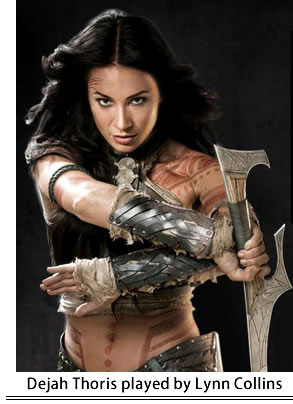 just so happens, is as human as Carter. She is also exotically beautiful with ruddy skin, coal black hair, lovely eyes, and a curvaceous figure covered only by a few pieces of strategically placed jewelry. Her name is Dejah Thoris. She is the grand-daughter of Mars's most powerful ruler, the jeddak of Helium, and becomes a prized captive of the greens.
just so happens, is as human as Carter. She is also exotically beautiful with ruddy skin, coal black hair, lovely eyes, and a curvaceous figure covered only by a few pieces of strategically placed jewelry. Her name is Dejah Thoris. She is the grand-daughter of Mars's most powerful ruler, the jeddak of Helium, and becomes a prized captive of the greens.
When it is all said
and done, Carter saves Dejah Thoris, saves Helium from a treacherous rival power, and saves Mars from the breakdown of the plant that produces the air that replenishes the Martian atmosphere. At which point of triumph, the long-suffering Carter is spiritually transported back to earth. There he pines to return to Mars and Dejah.
Therns Are Bald, Mean,
And in the Wrong Place.
If you have seen John Carter, you'll probably agree that my description of the novel's story line and major characters pretty much mirrors the tale told by the movie. But there are some differences. Most significantly, the film introduces the Therns, a rather nasty white race of bald guys who appear prominently at the very start of the movie. The Therns control a religion that runs a horrendous confidence game on the inhabitants of Mars, a plot device that doesn't appear until the second installment of the series, The Gods of Mars. The film also changes the nature of the Therns, who wear blonde wigs in print but always appear as just plain old bald guys in the movie. They also possess super-technology, which controls the transport of Carter from Earth to Mars. And they can shape shift. The book version of the Therns are just Martian versions of the Wizard of Oz, normal men using fakery and smoke and mirrors to look powerful and supernatural.
The Therns are up to no good on both Mars and Earth. On the Red Planet, the particular “no-good” is giving the ruler of the predator city of Zodanga a weapon so powerful that it will enable him to conquer the planet. Faced with the utter destruction of his people, Dejah Thoris’s grandfather is forced to offer his beautiful granddaughter as bride for the odious Zodanga despot. I won’t spoil the ending by letting you know how that turns out.
A Virginian with a Wedding Ring.
The John Carter of both book and film is a Virginian and a Civil War veteran. In the book, Carter is left broke by the ravages of
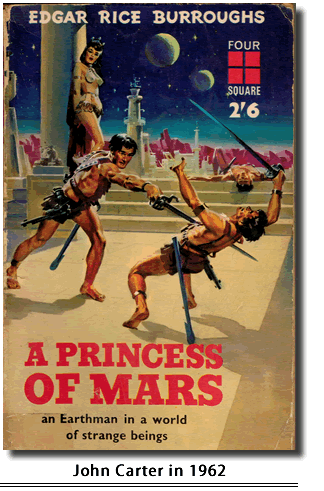 the Civil War and goes to Arizona in the hope of finding gold. It is implied that the war ruined his family fortune. Carter is also a man of mystery who is already ageless and has no memory of his childhood. The film portrays Carter as a widower, happily married to a pretty blonde wife, and father to a pretty blonde child. But when he returns home at the end of the war, he finds that his family has been killed and his farm destroyed. He continues to wear his wedding ring, and memories of his wife cause him to be a bit tentative in his budding romance with the gorgeous Dejah Thoris, much to her consternation.
the Civil War and goes to Arizona in the hope of finding gold. It is implied that the war ruined his family fortune. Carter is also a man of mystery who is already ageless and has no memory of his childhood. The film portrays Carter as a widower, happily married to a pretty blonde wife, and father to a pretty blonde child. But when he returns home at the end of the war, he finds that his family has been killed and his farm destroyed. He continues to wear his wedding ring, and memories of his wife cause him to be a bit tentative in his budding romance with the gorgeous Dejah Thoris, much to her consternation.
Ex-Confederates being portrayed as widowers with a slain family is not a unique plot device in recent film and television. The Bohannon character in the downbeat and gritty AMC series Hell on Wheels is also a Virginian whose family was massacred in the war. It is a device that the writers ought to drop as it gives a rather skewed view of how the Civil War was fought.
The film's depiction of Martian women is thoroughly up to date. Green Martian women are portrayed in Burroughs’s novel as just as savage as their men, only a bit smaller. Sola, Carter’s green Martian caretaker, is an exception in that she is kind and loving. In the film, red Martian women are depicted from the first scene serving as soldiers and fighting besides the men. Keep in mind, the heroines of Burroughs's stories are always spunky, resourceful, and determined. The film’s Dejah Thoris is quite proficient at swordplay. When Carter and Dejah Thoris first meet, she proves to be more adept with a sword than Carter.
The Cast Fits the Tale.
Apart from the vaguely drawn but clearly nefarious Therns, the film
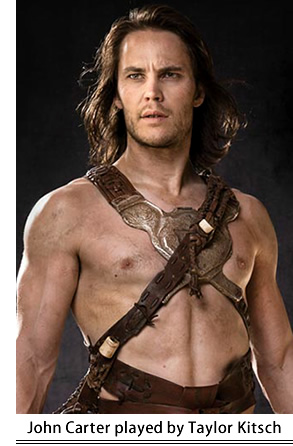 does a very good job of translating A Princess of Mars to the silver screen. Taylor Kitsch, a Canadian, was well chosen to portray John Carter, although Burroughs’s Carter did not wear his hair long. Lynn Collins, an American from Texas, makes an excellent Dejah Thoris. The prematurely introduced Thern leader Matai Shang is ably played by that perpetual villain Mark Strong. Disney filmed much of John Carter at London studios, so the red Martians are generally British in contrast to Carter’s American/Canadian. Ciaran Hinds plays Dejah Thoris’s grandfather, the jeddak of Helium, while Dominic West is the brutal but dull Sab Than of Zodanga.
does a very good job of translating A Princess of Mars to the silver screen. Taylor Kitsch, a Canadian, was well chosen to portray John Carter, although Burroughs’s Carter did not wear his hair long. Lynn Collins, an American from Texas, makes an excellent Dejah Thoris. The prematurely introduced Thern leader Matai Shang is ably played by that perpetual villain Mark Strong. Disney filmed much of John Carter at London studios, so the red Martians are generally British in contrast to Carter’s American/Canadian. Ciaran Hinds plays Dejah Thoris’s grandfather, the jeddak of Helium, while Dominic West is the brutal but dull Sab Than of Zodanga.
I went to see John Carter expecting to be mildly let down and possibly outraged by some egregious and unnecessary distortion of the original plot. The fact is, John Carter far exceeded my expectations, low as they were when I entered the theater. My understanding is that the box office for the film’s first weekend was mediocre but that word of mouth has generally been quite good. That certainly mirrors my experience. I would recommend seeing the movie if you like science fiction and swordplay. John Carter is a much better film adaptation than the incredibly disappointing Conan films starring Arnold Schwarzenegger. And that was not Arnold’s fault. He was perfect casting as Conan!
The film leaves an opening for sequels. One based on The Gods of Mars is planned. But unless the ticket sales pick up, I suspect that will never happen. Part of the problem may lie in the title. As my essay title asks, for many people the question would be, who is John Carter? Maybe they should have stuck with A Princess of Mars.
How Old Is Your Duck Soup?
Film critics have not been kind to John Carter. They offer the usual snide remarks about it being derivative and we’ve seen this all before. But that kind of criticism demonstrates that the critics are perhaps a bit ignorant of the novel, a hundred-year-old novel at that. They might consider that A Princess of Mars is a sort of ur-text for science fiction/fantasy swordplay stories. It reminds me of watching the Marx Brothers in Duck Soup with a college freshman, a student of mine. We were stuffing envelopes for a mass mailing while the VCR was playing the 1933 comedy classic. With the obligatory blasé and jaded attitude of a world-weary teenager, the student said, "Those jokes are old." To whom? Those quirky brothers created the jokes way back in the 1920s and 1930s. They weren’t old then. Nor for the astute and aware film critic of 2012 is John Carter derivative. Rather, it is derived from. If you like science fiction, if you are a fan of Edgar Rice Burroughs (or both), then see the film and enjoy.



Click on the black panther to read about Ron Fritze's latest book,
Invented Knowledge: False History, Fake Science, and Pseudo-religions.
|
 |
















 |
 |



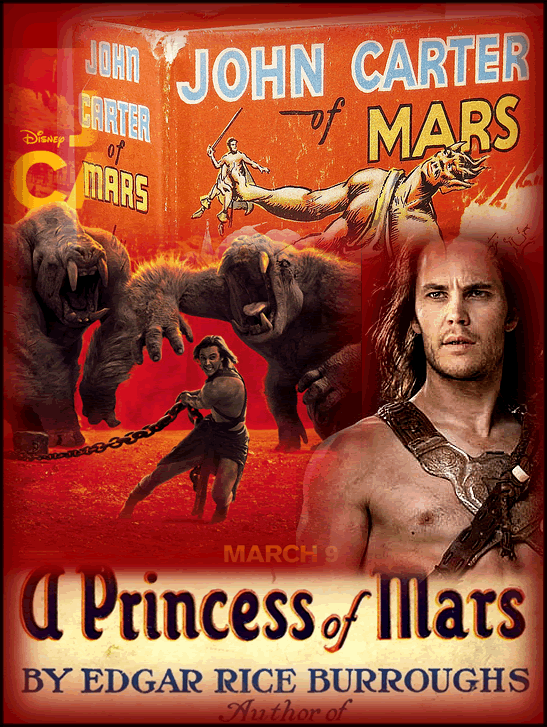

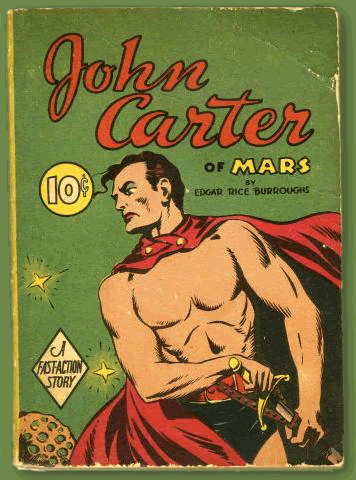
 is one third of earth’s, so whatever Carter could do on earth, he could do at least three times better, higher, and farther on Mars. Carter finds Mars to be a desert world that is slowly dying due to loss of water and atmosphere. Former seas are now waterless basins covered in a yellow moss. Living on this harsh land are several races, including the race of Carter's first contact, green men who stand 12-to-15 feet tall with two pairs of arms. They are ugly creatures, very, very warlike and devoid of tender emotion. For them, intense cruelty passes for humor, which means that the culture of green Martians is stuck at the level of many American high schools.
is one third of earth’s, so whatever Carter could do on earth, he could do at least three times better, higher, and farther on Mars. Carter finds Mars to be a desert world that is slowly dying due to loss of water and atmosphere. Former seas are now waterless basins covered in a yellow moss. Living on this harsh land are several races, including the race of Carter's first contact, green men who stand 12-to-15 feet tall with two pairs of arms. They are ugly creatures, very, very warlike and devoid of tender emotion. For them, intense cruelty passes for humor, which means that the culture of green Martians is stuck at the level of many American high schools.  just so happens, is as human as Carter. She is also exotically beautiful with ruddy skin, coal black hair, lovely eyes, and a curvaceous figure covered only by a few pieces of strategically placed jewelry. Her name is Dejah Thoris. She is the grand-daughter of Mars's most powerful ruler, the jeddak of Helium, and becomes a prized captive of the greens.
just so happens, is as human as Carter. She is also exotically beautiful with ruddy skin, coal black hair, lovely eyes, and a curvaceous figure covered only by a few pieces of strategically placed jewelry. Her name is Dejah Thoris. She is the grand-daughter of Mars's most powerful ruler, the jeddak of Helium, and becomes a prized captive of the greens. the Civil War and goes to Arizona in the hope of finding gold. It is implied that the war ruined his family fortune. Carter is also a man of mystery who is already ageless and has no memory of his childhood. The film portrays Carter as a widower, happily married to a pretty blonde wife, and father to a pretty blonde child. But when he returns home at the end of the war, he finds that his family has been killed and his farm destroyed. He continues to wear his wedding ring, and memories of his wife cause him to be a bit tentative in his budding romance with the gorgeous Dejah Thoris, much to her consternation.
the Civil War and goes to Arizona in the hope of finding gold. It is implied that the war ruined his family fortune. Carter is also a man of mystery who is already ageless and has no memory of his childhood. The film portrays Carter as a widower, happily married to a pretty blonde wife, and father to a pretty blonde child. But when he returns home at the end of the war, he finds that his family has been killed and his farm destroyed. He continues to wear his wedding ring, and memories of his wife cause him to be a bit tentative in his budding romance with the gorgeous Dejah Thoris, much to her consternation. does a very good job of translating A Princess of Mars to the silver screen. Taylor Kitsch, a Canadian, was well chosen to portray John Carter, although Burroughs’s Carter did not wear his hair long. Lynn Collins, an American from Texas, makes an excellent Dejah Thoris. The prematurely introduced Thern leader Matai Shang is ably played by that perpetual villain Mark Strong. Disney filmed much of John Carter at London studios, so the red Martians are generally British in contrast to Carter’s American/Canadian. Ciaran Hinds plays Dejah Thoris’s grandfather, the jeddak of Helium, while Dominic West is the brutal but dull Sab Than of Zodanga.
does a very good job of translating A Princess of Mars to the silver screen. Taylor Kitsch, a Canadian, was well chosen to portray John Carter, although Burroughs’s Carter did not wear his hair long. Lynn Collins, an American from Texas, makes an excellent Dejah Thoris. The prematurely introduced Thern leader Matai Shang is ably played by that perpetual villain Mark Strong. Disney filmed much of John Carter at London studios, so the red Martians are generally British in contrast to Carter’s American/Canadian. Ciaran Hinds plays Dejah Thoris’s grandfather, the jeddak of Helium, while Dominic West is the brutal but dull Sab Than of Zodanga.
